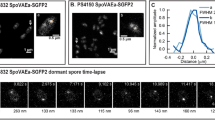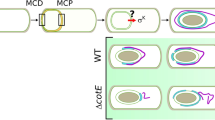Abstract
THE dormant bacterial spore consists of a core surrounded by a structure called the cortex which in turn is bounded by a structure called the coat. The core contains cytoplasm plus nuclear material and the cortex contains mucopeptide1. The coat is mainly protein2,3 with a high cystine disulphide bond content4. We have been unable to liberate cores by enzymatic digestion of spore coats using a variety of proteolytic enzymes including keratinase5 before or after treatment of spores with reagents which rupture disulphide bonds6. We therefore investigated the possibility of releasing cores by mechanical breakage of spores.
This is a preview of subscription content, access via your institution
Access options
Subscribe to this journal
Receive 51 print issues and online access
$199.00 per year
only $3.90 per issue
Buy this article
- Purchase on Springer Link
- Instant access to full article PDF
Prices may be subject to local taxes which are calculated during checkout
Similar content being viewed by others
References
Warth, A. D., Ohye, D. F., and Murrell, W. G., J. Cell. Biol., 16, 579 (1963).
Yoshida, N., et al., J. Bact., 74, 94 (1957).
Salton, M. R. J., and Marshall, B., J. Gen. Microbiol., 21, 415 (1959).
Vinter, V., Spores, 2, 127 (Burgess Publishing Co., Minneapolis, Minnesota, 1961).
Nickerson, W. J., Bact. Revs., 27, 305 (1963).
Gould, G. W., and Hitchins, A. D., J. Gen. Microbiol., 33, 413 (1964).
Edebo, L., Acta Path. Microbiol. Scand., 53, 121 (1961).
Powell, J. F., Biochem. J., 54, 210 (1953).
Curran, H. R., Brunstetter, B. C., and Myers, A. T., J. Bact., 45, 484 (1943).
Levinson, H. S., Hyatt, M. T., and Moore, F. E., Biochem. Biophys. Res. Comm., 5, 417 (1961).
McKinney, R. E., J. Bact., 66, 453 (1953).
Wilcox, jun. F. H., and Daniell, L. J., Arch. Biochem. Biophys., 52, 305 (1954).
Gould, G. W., Georgala, D. L., and Hitchins, A. D., Nature, 200, 385 (1963).
Boas, N. F., J. Biol. Chem., 204, 553 (1953).
Jansen, F. W., Lund, A. J., and Anderson, L. E., Science, 127, 26 (1958).
Perry, J. J., and Foster, J. W., J. Bact., 69, 337 (1955).
von Daryáni, J., Zentral Bakteriol. Parasitenk., 71, 353 (1927).
Lewis, J. C., Snell, N. S., and Burr, H. K., Science, 132, 544 (1960).
Warth, A. D., Ohye, D. F., and Murrell, W. G., J. Cell. Biol., 16, 593 (1963).
Alderton, G., Thompson, P. A., and Snell, N., Science, 143, 141 (1964).
Author information
Authors and Affiliations
Rights and permissions
About this article
Cite this article
HITCHINS, A., GOULD, G. Release of Cores from Bacterial Spores by Mechanical Breakage in Acidic Media. Nature 203, 895–896 (1964). https://doi.org/10.1038/203895b0
Issue Date:
DOI: https://doi.org/10.1038/203895b0
This article is cited by
-
Spores of microorganisms
Folia Microbiologica (1974)
-
Spores of microorganisms
Folia Microbiologica (1967)
Comments
By submitting a comment you agree to abide by our Terms and Community Guidelines. If you find something abusive or that does not comply with our terms or guidelines please flag it as inappropriate.



